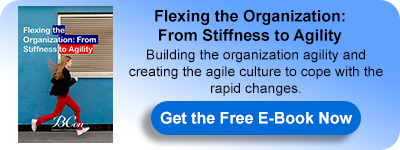Shifting to the New Organization
The corporate world has experienced more turbulence during the past two to three years than in the past nine years, necessitating new and urgent adjustments. Initiatives are springing up by the dozen, acceptance is lagging, and the stakes are more significant than they've ever been. Change isn't about fine-tuning amid a Covid-induced recession, and with some industries on the verge of extinction, it's about survival.
On the other hand, traditional change management, which is generally characterized by extensive processes, protracted schedules, and clumsy rollouts, isn't going to cut it right now. Organizations are fundamentally rethinking their product and service portfolios, reinventing their supply chains, pursuing large-scale organizational restructuring, determining how to operate in a virtual world, and rebuilding to correct systemic racism from the ground up. Hence, the type of change management required at this time is quick, agile, and (in many cases) virtual. 1
Shifting to The New Organization
A worldview, or paradigm, will persist until it can no longer explain fresh facts. The paradigm must then adjust to accommodate the new data. Organizations' approaches to balancing stability and dynamism are presently undergoing a paradigm shift.
First, let's look at the old paradigm. The Ford Motor Company was one of the numerous tiny car manufacturers in 1910. Ford had a 60 percent market share of the global new car market a decade later. Ford cut the time it took to assemble a vehicle from 12 hours to 90 minutes and the cost from $850 to $300, all while paying employees a competitive wage.
Scientific management, a breakthrough discovery that enhanced worker productivity through the scientific method, spawned Ford’s, and Frederick Taylor's theories, ushering in an era of extraordinary effectiveness and efficiency. Thanks to Taylor's student Henry Gantt, Taylor's concepts foreshadowed current quality control, total quality management, and project management.
Taylorist organizations, such as Ford, are described as hierarchical and specialized by Gareth Morgan, who depicts them as machines.
For decades, companies that adopted this machine model and scientific management concepts dominated their markets outperformed competitors and attracted the most significant personnel. The "management century" lasted from 1911 to 2011.
In the face of the organizational problems posed by the "digital revolution" reshaping companies, economies, and communities, the machine paradigm is shifting. This is reflected in the following four contemporary trends:
A rapidly changing environment. Customers, partners, and regulators have pressing requirements; investors need growth, which leads to acquisitions and restructuring; and competitors and collaborators demand action to keep up with rapidly shifting priorities.
Disruptive technology is constantly being introduced. Digitization, bioscience developments, and automation are commoditizing or replacing established enterprises and industries. Machine learning, the Internet of Things, and robotics are examples of recent breakthroughs.
Information democratization and digitization are being accelerated. Organizations must quickly engage in multidirectional communication and complicated collaboration with consumers, partners, and colleagues due to the increased volume, transparency, and diffusion of information.
A fresh talent battle has erupted. Organizations require a distinct value offer to acquire and retain the greatest talent, typically more diversified, as innovative knowledge and learning-based tasks become more crucial. These "learning workers" may come from various backgrounds, have multiple ideas, compositions, and experiences, and may have distinct goals (for example, millennials).
Many machine organizations' attempts to engage with the new environment have failed terribly. Only less than 10% of non-financial S&P 500 companies in 1983 stayed in the S&P 500 in 2013. From what we've seen, machine organizations also have a lot of internal churns. According to the survey2 conducted to 1,900 executives found that they are changing their strategy (and organizational structure) more frequently than in the past. In the last three years, 82 percent have undergone a redesign. However, most of these redesign initiatives fail, with only 23% of them succeeding.
The changes, as mentioned earlier, are drastically altering how businesses and employees operate. So, for the next 100 years, what will be the dominating organizational paradigm? How will businesses strike a balance between stability and dynamism? Furthermore, which companies will be market leaders and attract the most remarkable talent?
The paradox that really allows organizations to master this new paradigm is the paradigm of the agile organizations—they are both steady and dynamic at the same time—this paradigm and mindset achieve this equilibrium. 3
1HBR, 11 Jan 2021, Sarah Jensen Clayton, An Agile Approach to Change Management, Accessed 15 April 2022, https://hbr.org/2021/01/an-agile-approach-to-change-management
2Steven Aronowitz, Aaron De Smet, and Deirdre McGinty, “Getting organizational redesign right,” McKinsey Quarterly, June 2015.
3 Mckinsey and Company, 22 Jan 2018, Wouter Aghina, Karin Ahlback, Aaron De Smet, Gerald Lackey, Michael Lurie, Monica Murarka, and Christopher Handscomb, The five trademarks of agile organizations, Accessed 25 April 2022, https://www.mckinsey.com/business-functions/people-and-organizational-performance/our-insights/the-five-trademarks-of-agile-organizations
For more about this topic, download our latest book " Flexing the Organization: From Stiffness to Agility " for FREE:
